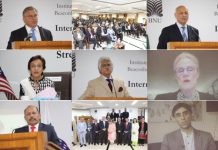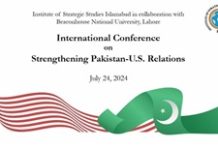North East Asian international relations have been revolving around China and Japan. Their ties are shaky and awkward. They are based upon many hostile factors impeded in history. On the other hand, they had strong historical and cultural relations. Confucius values, art, law and so on so forth bring them together. Japanese language is only complete after learning a large number of Chinese characters; say from 2000 to 5000.
With such a strong common cultural influence, how come relations were so much hurt between them? Wars and Japanese imperial drive to colonize China were the responsible factors, inter alia. The modernization of Japan was based upon China’s exploitation and this process continued until 1945.
Relations were only improved in 1972 when Japanese Prime Minister Kakuei Tanaka visited Peking and met with Premier Chuo Enlai and restored ties after the ‘Nixon Shock’ as America opened up a dialogue with China without taking Japan into confidence. Tanaka and Chuo Enlai discussed Senkaku/Diaoyu Island issue but Chuo Enlai desired to discuss it some other time. Probably, he thought of it as an ‘insignificant matter’ at that time as political and diplomatic normalization was supreme.
China was more interesting in coming out of its international isolation. The visit of Nixon and Tanaka to Peking provided a good opportunity in recognizing the legitimate status of China in world’s affairs than Taiwan representing the people of China in the United Nations. People’s Republic of China adopted ‘One China’ policy. It was not known that the small island issue would become the bone contention in later years between China and Japan. The dispute has been further damaging their ties since 2010.
The real issue between China and Japan was the latter’s recognition of Taiwan as the sole legitimate government of the people of China but against ground realities.
A wise Japanese leader, Prime Minister, Shigeru Yoshida, however, remarked ‘red or white, China remains our next-door neighbor. Geography and economic laws will prevail in the long-run over any ideological differences and artificial trade barriers ’. So Japan opened up trade with Japan during the ‘heydays’ of the Cold War in the 1950s. Japan should base its China policy on Yoshida’s wisdom and China should base its Japan policy on Chou Enlai’s wisdom to avoid confrontation on Diaoyu/Senkaku issue. The issue is the most insignificant and unsubstantial furry between these two great powers.
The Korean War missed out an the opportunity to normalize China-Japan ties in the early 1950s. The bundle of opportunities available now should not be missed out again. A robust Sino-Japanese relationship would bring peace in the large Asia-Pacific region.
Bilaterally, China and Japan are avoiding a dialogue to lower down tension. Leaders of these two powerful North East Asian countries however, are not reluctant to see each other at international fora.
Chinese President Xi Jinping and Japanese Prime Minister Shinzo Abe met each other for the second time in Jakarta at the Afro-Asian Conference on 22 April. Earlier, they met in November last at the sidelines of the Asia-Pacific Economic Cooperation (APEC) in Beijing. Let’s hope that this new thaw in their relations would become a milestone in improving their ties.
These are ice-breaking gestures from both sides. Xi talked to Abe about China’s recent “One Belt, One Road” initiative and the establishment of the AIIB. He invited Japan to become a member of the AIIB, Japan is even planning to join the Chinese-sponsored Asia Infrastructure Investment Bank (AIIB) and trying to avoid making remarks against it as a rival to the Japanese-led Asian Development Bank (ADB), set up way back in 1966 at Manila. The ‘One Belt-One Road’ policy and AIIB present great opportunities to both nations to boost Asian economies as both China and Japan are advanced global economies.
Diaoyu/Senkaku/Islands, counter claim by both nations creates panic in their mutual relations after the renewed claims put forward in 2010. The Tokyo-based Yasukuni shrine is a symbol of controversy between the two countries. China and many East Asian nations regard it as a symbol of Japanese militarism and war time atrocities and curse. Strangely, Japanese ministers just paid tributes to the shrine hours after Abe met with Xi.
Japan expressed remorse and offered apology to China and other East Asian nations for its war time’s atrocities time and again but they continue to be asking the same from Japan that could only hurt the ties. All need to move several steps forward from this point or instead of starting from zero-sum game. All are developed or emerging economies and let China and Japan and others to learn from their developmental experience.
These are historical disputes and they are difficult to settle down finally but they can move on by lowering down tension on these fronts. When these differences are once frozen, there would be a prospect to improve their ties.
Views expressed are of the author and do not necessarily reflect the views of ISS or of the Government of Pakistan.













